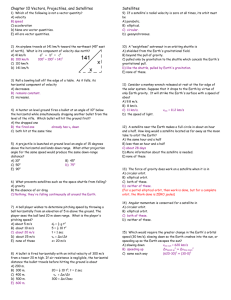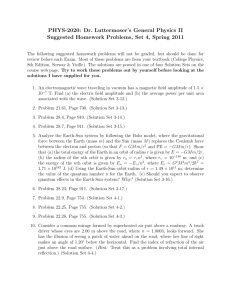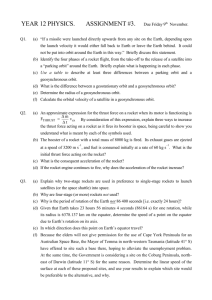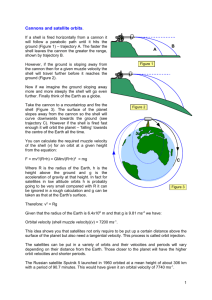fulltext
advertisement
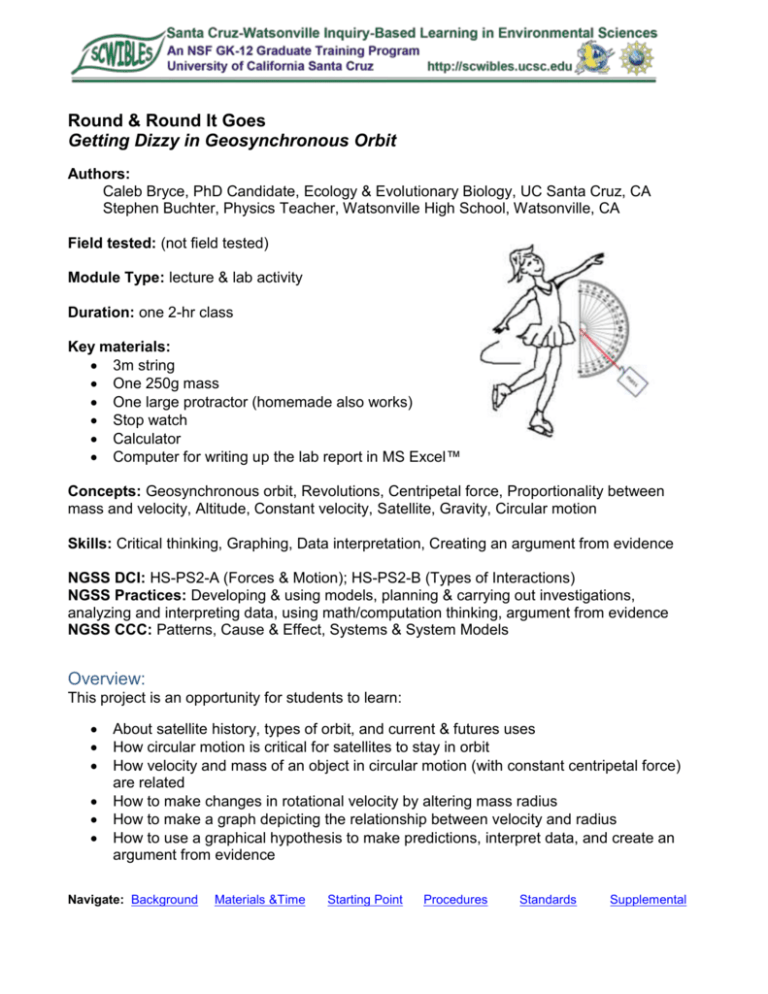
Round & Round It Goes Getting Dizzy in Geosynchronous Orbit Authors: Caleb Bryce, PhD Candidate, Ecology & Evolutionary Biology, UC Santa Cruz, CA Stephen Buchter, Physics Teacher, Watsonville High School, Watsonville, CA Field tested: (not field tested) Module Type: lecture & lab activity Duration: one 2-hr class Key materials: 3m string One 250g mass One large protractor (homemade also works) Stop watch Calculator Computer for writing up the lab report in MS Excel™ Concepts: Geosynchronous orbit, Revolutions, Centripetal force, Proportionality between mass and velocity, Altitude, Constant velocity, Satellite, Gravity, Circular motion Skills: Critical thinking, Graphing, Data interpretation, Creating an argument from evidence NGSS DCI: HS-PS2-A (Forces & Motion); HS-PS2-B (Types of Interactions) NGSS Practices: Developing & using models, planning & carrying out investigations, analyzing and interpreting data, using math/computation thinking, argument from evidence NGSS CCC: Patterns, Cause & Effect, Systems & System Models Overview: This project is an opportunity for students to learn: About satellite history, types of orbit, and current & futures uses How circular motion is critical for satellites to stay in orbit How velocity and mass of an object in circular motion (with constant centripetal force) are related How to make changes in rotational velocity by altering mass radius How to make a graph depicting the relationship between velocity and radius How to use a graphical hypothesis to make predictions, interpret data, and create an argument from evidence Navigate: Background Materials &Time Starting Point Procedures Standards Supplemental Geosynchronous Orbit Background for Teachers Why this matters: Whether we realize it or not, artificial (man-made) satellites are incredibly important in our daily lives. Satellites help meteorologists predict weather and track hurricanes; assist astronomers by recording images of the sun, other planets, and faraway galaxies; help us navigate with GPS in our phones and cars; and are critical for beaming TV signals and phone calls around the world. Some satellites must “hover” over one place on the earth’s surface. How do they do this? They have to follow a geosynchronous orbit. This lab introduces students to the simple physics behind geosynchronous orbits, which keep satellites “hovering” above the earth by intentionally matching the earth’s rotational period. Through a dizzying experiment, students will work together find the proportionality relationship between the size of the radius and the velocity of an object in circular motion, graph their data showing this relationship, then use computational and critical thinking skills to calculate the gravitational force needed to keep a satellite in geosynchronous orbit. The spinning mass represents an orbiting satellite while the spinner represents the earth or some other orbiting object. Just as the spinner faces toward the orbiting mass, so too the earth and satellites “face” one another continually if the satellite is in geosynchronous orbit. At the end of the lab, students are asked to compare and contrast the lab’s spinning mass activity with that of satellites in orbit. Assumed background: Familiarity with the concepts of velocity, centripetal force, gravity, altitude (defined with others in glossary below) Ability to identify a plot as a general function type (e.g. linear, quadratic, exponential… their data will generate a square-root function as satellite velocity is proportional to the square root of the radius… see below). Knowledge of what an r2 value means (correlation coefficient… how well the models fits the data... r2 closer to 1 means better model fit, etc) Special context: Above us there are at least 2,500 artificial satellites currently orbiting earth, though ~2/3 are no longer functioning. Both national governments and private corporations own satellites, which range in size from 2 lbs to 6 tons (12,000 lbs)! Satellites play a wide variety of roles, including aiding navigation (GPS satellites), relaying telephone or TV signals (communication satellites), forecasting weather, and informing national defense, science (e.g. astronomy & astrophysics), and agriculture (monitoring crops and regions of drought). Approximately 60% of satellites are used for communications, and these satellites rely on geosynchronous orbits to stay above the same place on earth’s surface. Other satellites that have geosynchronous orbits include classified military satellites and some weather satellites, though not global positioning (GPS) satellites. Scaffolding supplements Satellites & Geosynchronous Orbit (Bryce_Orbit_orbitslect.pptx): an interactive intro to assess students prior knowledge of gravity and circular motion and introduces satellites/geosynchronous orbits Introduction to the Geosynchronous Lab (4:13min video, avail. HERE): demonstrates lab group member roles and how to conduct the lab activity © 2014 SCWIBLES NSF GK-12 Program at UC Santa Cruz http://scwibles.ucs.edu 2 Geosynchronous Orbit Geosynchronous Lab Report (Bryce_Orbit_labworksheet.xlsx): all lab procedures, data tables, graphing tools, and assessment questions are included in this multi-worksheet Satellite Motion_MC_summative_assessment (Bryce_Orbit_quiz.pptx): assesses individual student understanding of Newton’s Universal Law of Gravitation Proportionality between velocity V and radius r (Bryce_Orbit_Vandrlect.pptx): derives the proportionality between V and r for the geosynchronous orbit laboratory…summarized here: …Newton’s 2nd Law of Motion ∑ ⃗F = ma⃗ In this case the only force on the body is the force of gravity and the acceleration of the body is centripetal. FG = FC v2 Fc m1 ( ) A centripetal force is required for circular motion. This is given by: r The centripetal force is supplied by the force of gravity between the two bodies: Gm1m2 FG r2 Set the two forces equal to one another: m1 = mass of the satellite FG = FC m2 = mass of object being orbited 2 Gm1m2 v V = velocity of the satellite m1 r2 r G = universal gravitational constant Gm1m2 v2 r = radius of the circular motion m1 r2 r Mass of the satellite cancels out. The speed of the satellite depends on radius r and mass m of the object being orbited. Orbital Velocity: solving for v v Gm r Where: v = orbital velocity (m/s) G = universal gravitational constant = 6.67 x 10-9 m = mass of the object being orbited (kg) r = radius of circular motion (m) Derivation of the proportionality of velocity and radius under constant centripetal force (Bryce_Orbit-derivation.pptx): a presentation to explain the relationship between V and r when experiencing centripetal force…summarized here: To ensure a constant centripetal force the angle with the vertical is kept at a constant 45 degrees. The only force on the body horizontally is the horizontal force of tension in the string and the acceleration is centripetal and towards the center. Solving, substituting, etc: 𝒗 = (𝒂 𝒄𝒐𝒏𝒔𝒕𝒂𝒏𝒕) ∗ √𝒓 In other words: 𝑭𝑻 𝒔𝒊𝒏𝜽 = 𝒎 𝒗𝟐 𝒓 𝐯 ∝ √𝐫 © 2014 SCWIBLES NSF GK-12 Program at UC Santa Cruz http://scwibles.ucs.edu 3 Geosynchronous Orbit Module Description Materials • Each lab group (4 students) needs the following: • 3m string • One 250g mass • One large protractor (for homemade see “Preparation” below) Stop watch • • Calculator • Computer for writing up the lab report in Excel™ Preparation • During the class period before this lab activity, ask students to do their own research at home on a satellite of their choice. Each student should collect the following information (if available) to include in the group lab report (described below): • Name and type of satellite • Distance from Earth • If it is in geosynchronous orbit or not (mention that this term will be described in following class period through an interactive experiment) • Pre-measure and cut 3 m of string for each group • To make homemade “large protractors” as shown in the photo above, simply enlarge, print, and cut out a protractor image (e.g. HERE) and tape to cardboard. This can then be cut into the traditional semi-circle shape Timeline A. B. C. D. E. F. G. H. Satellites and Geosynchronous Orbit (pptx presentation): 15 min Intro to Geosynchronous Lab video: 4 min Description of lab report (MS Excel™) and how to complete it: 5 min Graphical hypothesis practice: 10min Geosynchronous orbit laboratory activity: 50 min Student time to work on the graphing and assessment questions: 30 min Powerpoint™ of clicker questions: 5 min Cleanup & debrief activity: 10 min Starting Point For Inquiry Though it feels like we’re sitting stationary, Earth is actually orbiting around the sun at 67,000 miles per hour and spinning around on its axis at around 1000 miles per hour (assuming we’re on the equator)! Since we’re quite far north of the equator, our surface speed in Santa Cruz is ~850mph - still very fast! Similarly, the moon is orbiting around the earth, as are thousands of man-made satellites that serve a host of functions for people, from taking clear photos of space to national security and agricultural monitoring to helping you travel from here to there with the GPS on your phone! In this activity, students will learn about satellites and circular motion, then experience first-hand how the radius of an orbiting mass affects it’s velocity in circular motion. The intent of this two-hour period is to help students develop a greater appreciation for satellites and other orbiting bodies as well as provide them with a basic understanding of the physics behind these processes. © 2014 SCWIBLES NSF GK-12 Program at UC Santa Cruz http://scwibles.ucs.edu 4 Geosynchronous Orbit Detailed Procedure NOTE: the lab report in its entirety is presented to the students as an Excel™ spreadsheet with multiple worksheets (i.e. tabs) to organize the content (Bryce Orbit Lab.xlsx; worksheets: Procedure, Data Table & Figure, Questions, Eqns & Addn’l Information). Cells where students must enter data or provide an answer are clearly marked (highlighted). Students pick a lab team name, and save their xlsx file with this name as follows: “Team Name_Geosynchronous Orbit Lab.xlsx” before sending to instructor for grading or submitting to online school portal such as SchoolLoop. A. Satellites & Geosynchronous Orbit (pptx presenation, 15 min.) a. This presentation is intended to excite students about satellites as well as satellite motion and different types of orbits. b. It will be presented in an interactive Q&A format (prompts available in “Formative assessment warm up.pptx”) to gauge student familiarity with satellites, gravitation, and circular motion. B. Intro to Geosynchronous Lab video (4:13 min.) a. This short video (found on YouTube HERE) demonstrates the various roles of lab group members while performing the spinning experiment to study the relationship between the size of the radius and the velocity of an object in circular motion. b. Like the .pptx presentation immediately preceding it, this video should continue to excite the students about the lab they are about to conduct C. Description of lab report (Microsoft Excel™) and how to complete it (5 min) a. Because most students are accustomed to completing lab reports on lab handouts (paper), this brief description of the lab’s electronically submitted report is critical to student understanding and proper assignment completion b. The instructors will project the .xlsx spreadsheet on the screen for the students to follow along as he/she points out where to find the information for various segments of the lab (i.e. the worksheets/tabs) and demonstrates how data entered into the data table will automatically generate a velocity vs radius figure below. c. IMPORTANT: Instructor(s) tell students to enter their lab group name and lab group member names at the top of the first worksheet in the .xlsx file. Instructor(s) also shows students where all highlighted cells are in the file, explaining that these cells must be filled in with data and answers in order to get credit for the assignment. D. Graphical Hypothesis Practice: a. On a sheet of paper, each group works together to design their own orbit experiment through a graphical hypothesis that graphically depicts their prediction for the relationship between the velocity and the radius of a mass in circular motion under constant centripetal acceleration. b. Students must talk through which variables are independent, dependent, and held constant in the experiment, then graph out what they expect the relationship looks like. Student-generated hypotheses will likely resemble one of the following lines (see graph below), with the actual relationship resembling the shape of the green or blue lines (the square root function as satellite velocity is proportional to the square root of the radius). © 2014 SCWIBLES NSF GK-12 Program at UC Santa Cruz http://scwibles.ucs.edu 5 Geosynchronous Orbit c. In order to advance to the orbit lab activity, the group must show & describe the following to their instructor: graphical hypothesis prediction(s) variables to be measured (stating which is dependent, independent, and held constant). Data table to organize the data they collect d. Correct answers: Graphical hypothesis: graph of velocity vs. the radius of a mass in circular motion under constant centripetal acceleration resembles blue or green lines above (positive, but asymptotic) Prediction: velocity of the orbiting mass will increase (but asymptote) with radius (string length) Independent variable (X axis): radius (string length) Dependent variable (Y axis): velocity of the orbiting mass Variables held constant: spinner’s speed, 45 degree string angle, etc e. *NOTE: efficient groups who complete the lab may be curious about how other factors affect the mass’ velocity (e.g. the actual mass of the mass, shape of the mass, angle of string on protractor). Such student-driven inquiry should be enthusiastically supported if time allows. E. Geosynchronous Orbit Laboratory Activity (60min; found in “Procedure” worksheet of .xlsx file & explained in the video) 1. Divide your group so that each person has a job. Each group needs a A) Spinner, B) Counter, C) Recorder, D) Timer; any extra people in the group can quietly help to be sure that the counter is being accurate and that the spinner is keeping the angle of the string at 45 degrees. 2. The spinner securely ties the mass on to the string. 3. The spinner measures out one meter of string and hangs the mass from the string. 4. The spinner holds the protractor vertically so the string is in the right spot to measure out an angle when the mass is spun in a circle. 5. The counter, recorder, and timer check to see that the spinner is holding the protractor vertical so that the angle can be accurately kept at 45 degrees while spinning. 6. The counter tells the spinner to spin (being careful not to let go of the mass!) until the string is at a 45 degree angle. 7. The counter counts out loud “Three…two…one: Mark!” 8. The timer starts the stop watch when they hear the word “Mark”. 9. The counter audible counts the number of revolutions the spinner makes. © 2014 SCWIBLES NSF GK-12 Program at UC Santa Cruz http://scwibles.ucs.edu 6 Geosynchronous Orbit 10. The timer stops and yells out the time when the counter counts “Ten!” for the 10th (and final) revolution of the spinner. 11. The recorder writes down (or enters directly into the “Data Table & Figure” worksheet) the time (duration in seconds) for 10 revolutions at the radius measured. 12. The spinner increases the radius by 0.05 meters and repeats steps 5 through 12 in the procedure until a radius of 2 meters is reached. F. Data Analysis and Lab Report Assessment 1. Students complete the questions within this worksheet by typing their answers directly into the highlighted cells. 2. All measured data are entered into the “Data Table & Figure” worksheet within the .xlsx file 3. A velocity vs. time graph is automatically constructed below the data table as this data is entered. 4. The lab group uses the shape and equation of the figure to describe which function (of the ones provided on the “Questions” worksheet) best describes the relationship between the velocity of the mass and the radius of its orbit. 5. Additional information for interpreting the data they gather and creating an argument based on evidence is presented in the “Eqns & Addn’l Information” worksheet G. Student time to work on the graphing and assessment questions (30 min.) 1. Instructor(s) available to answer student questions H. Clicker questions for students (5 min.) 1. 3-5 questions used to assess individual student understanding, Both quantitative and conceptual questions 2. 10-question version provided as “Satellite_Motion_MC_summative_Assessment.pptx,” instructors can pick questions from this .pptx depending on how much time is left in class I. Cleanup & debrief on activity (10 min.) a. Concluding remarks such as: “What went well? What didn’t go well?” “What would you change?” “In what ways was today’s spinning experiment like a satellite in space? How was it different?” Assessment Methods A formative Q&A can be incorporated into the introductory “Satellites & Geosynchronous Orbit.pptx” to assess students’ prior knowledge of gravity and circular motion. Sample questions are found in the pptx file: “Formative assessment warm up.pptx” After the lab (end of period or start of next period), student clicker questions will be used assess individual student understanding of Newton’s Universal Law of Gravitation as a summative assessment. These questions will address both quantitative and conceptual understanding and are found in the file: “Bryce_Orbit_quiz.pptx” Possible pitfalls Perhaps the most obvious consideration is that the repeated spinning could cause dizziness if not more severe motion sickness for particular students. For this reason, after each 10revolution measurement, students within the group switch roles so one person does not spin in consecutive measurements. Students especially prone to becoming dizzy will be encouraged to not fulfill the spinning role within the group. © 2014 SCWIBLES NSF GK-12 Program at UC Santa Cruz http://scwibles.ucs.edu 7 Geosynchronous Orbit To ensure this lab can be completed in one two-hour class, the velocity vs. radius figure is automatically constructed for the students as they populate the data table with the results from their spinning experiment. There may be a larger inquiry opportunity to have students teach themselves how to make the figure and associated trendline/equation/r2 values in Excel™, but the .xlsx format was new enough for students not to have additional components to slow them down. We are unsure of how students will do with completing a paperless lab report in Excel™. This switch from a traditional paper lab report was made for the following reasons: 1) keep a group’s lab report organized and readily “grade-able”, 2) foster student familiarity with using Excel™ to enter, analyze, and graph data (including trend lines), and 3) save trees. Glossary acceleration: the rate at which velocity is changing. The change may be in magnitude, direction, or both altitude: a distance measurement, usually in the vertical or "up" direction, between a reference datum and a point or object angular velocity: how fast the angle changes as one body revolves around another. It’s the change in radians per change in time centripetal force: a center-directed that causes an object to move in a curved (sometimes circular) path circular motion: a movement of an object along the circumference of a circle or rotation along a circular path. It can be uniform, with constant angular rate of rotation and constant speed, or non-uniform with a changing rate of rotation escape velocity: the minimum velocity necessary for an object to escape permanently from a gravitational field that hosts it force: any influence that tends to accelerate an object; a push or pull; measured in Newtons. A vector quantity geosynchronous: an orbit around the Earth with an orbital period of one sidereal day, intentionally matching the Earth's sidereal rotation period (approximately 23 hours 56 minutes and 4 seconds) gravity: the force that attracts a body toward the center of the earth, or toward any other physical body having mass orbit: the curved path a satellite follows around another body (usually under gravitational acceleration) period: the time it takes for an object orbiting another object to complete one revolution revolution: motion of an object turning around an axis outside the object rotational acceleration: the rate of change of angular velocity (the number of rotations or revolutions of an object per unit time together with a direction for the axis of rotation or revolution) satellite: a projectile that revolves around another body in free-fall motion sidereal day: the time it takes Earth to make one rotation relative to the vernal equinox © 2014 SCWIBLES NSF GK-12 Program at UC Santa Cruz http://scwibles.ucs.edu 8 Geosynchronous Orbit (approximately 23 hours 56 minutes and 4 seconds) velocity: speed together with direction of motion NGSS Standards Addressed Disciplinary Core Ideas PS2.A: Forces and Motion •Newton’s second law accurately predicts changes in the motion of macroscopic objects. (HS-PS2-1) PS2.B: Types of Interactions •Newton’s law of universal gravitation and Coulomb’s law provide the mathematical models to describe and predict the effects of gravitational and electrostatic forces between distant objects. (HS-PS2-4) •Forces at a distance are explained by fields (gravitational, electric, and magnetic) permeating space that can transfer energy through space. Magnets or electric currents cause magnetic fields; electric charges or changing magnetic fields cause electric fields. (HS-PS2-4), (HS-PS2-5) Science & Engineering Practices Developing & Using Models Planning & Carrying Out Investigations Analyzing and Interpreting Data Using Mathematics & Computational Thinking Engaging in an Argument from Evidence Cross Cutting Concepts Patterns Different patterns may be observed at each of the scales at which a system is studied and can provide evidence for causality in explanations of phenomena (HSPS2-4) Cause & Effect Different patterns may be observed at each of the scales at which a system is studied and can provide evidence for causality in explanations of phenomena (HSPS2-1, HS-PS2-5) Systems can be designed to cause a desired effect (HS-PS2-3) Systems & System Models When investigating or describing a system, the boundaries and initial conditions of the system need to be defined and their inputs and outputs analyzed and described using models. (HS-PS2-2) Guide to supplemental materials Lectures Satellites & Geosynchronous Orbits (Bryce_Orbit_orbitslect.pptx): introduces © 2014 SCWIBLES NSF GK-12 Program at UC Santa Cruz http://scwibles.ucs.edu 9 Geosynchronous Orbit students to the concepts of gravitation, satellites and orbits in an interactive presentation that gauges students previous knowledge and current interest Proportionality between velocity V and radius r (Bryce_Orbit_Vandrlect.pptx): derives the proportionality between V and r for the geosynchronous orbit laboratory Derivation of the proportionality of velocity and radius under constant centripetal force (Bryce_Orbit_derivationlect.pptx): this presentation explains the relationship between V and r when experiencing centripetal force Graphics Protractor (for printing, cutting out, and gluing to cut cardboard for homemade large protractor) All images embedded in “Bryce_ Orbit_labworksheet.xlsx” have associated weblinks in the cells immediately below them Labs (or Activities) See “Worksheets” below Worksheets Geosynchronous Orbit Lab (Bryce_Orbit_worksheet.xlsx): spreadsheet where students enter data and answer questions. This saved file is sent to the instructor via email or oneline homework submission interface for grading Videos Geosynchronous Orbit Lab Intro video: Available HERE; this 4:13 min video introduces the lab activity, roles for lab group members, and short instructions on where how and where to record and analyze data Assessment Materials Formative assessment warm up (Bryce_Orbit_prequiz.pptx) to assess students’ prior knowledge of gravity and circular motion Short (3-5 question) student clicker response presentation to assess individual student understanding of Newton’s Universal Law of Gravitation If time (or in next class period): Satellite motion summative assessment (Bryce_Orbit_quiz.pptx) © 2014 SCWIBLES NSF GK-12 Program at UC Santa Cruz http://scwibles.ucs.edu 10

